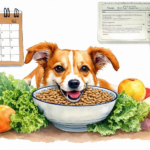Key Takeaways
- Enhance Dog Health: A raw dog food diet can significantly improve your dog’s overall health by providing high-quality proteins and essential nutrients.
- Better Digestion: Raw feeding promotes better digestion, resulting in firmer stools and less waste.
- Improved Coat Condition: Dogs on a raw diet often exhibit healthier skin and a shinier coat due to omega fatty acids.
- Weight Management: Raw dog food allows for better calorie control, aiding in maintaining a healthy weight.
- Common Misconceptions: Address myths around raw feeding, such as safety concerns and nutrient completeness, to make informed dietary choices.
- Daily Feeding Guidelines: Transitioning to a raw diet for dogs should be gradual, with careful monitoring of your dog’s health during the process.
- Stay Informed: Keep track of dog food recalls to ensure your pet’s safety when choosing raw food options.
In recent years, the trend of feeding raw dog food has gained significant traction among pet owners seeking to enhance their dogs’ health and well-being. But is raw food actually good for dogs? This article delves into the myriad benefits of a raw dog food diet, exploring its nutritional advantages and addressing common misconceptions surrounding raw feeding dogs. We will also provide insights into the best raw food options available, including top recommendations for different breeds and homemade raw dog food recipes. Additionally, we will analyze the cost comparison between buying and making raw dog food, helping you determine the most budget-friendly approach. For those wondering if they can feed their dogs raw food every day, we’ll outline daily feeding guidelines and tips for transitioning to a raw diet for dogs. Lastly, we will guide you on finding local suppliers and staying informed about dog food recalls, ensuring your furry friend enjoys a safe and nutritious diet. Join us as we uncover the essentials of raw dog food and empower you to make informed choices for your beloved pet.
Understanding the Benefits of Raw Dog Food
Raw dog food has gained popularity among pet owners seeking to enhance their dogs’ health and well-being. This diet, which emphasizes uncooked meats, fruits, and vegetables, is believed to offer numerous nutritional advantages that can lead to improved vitality and longevity in dogs. By understanding the benefits of raw dog food, pet owners can make informed decisions about their furry friends’ diets.
Nutritional Advantages of Raw Dog Food
The primary appeal of a raw dog food diet lies in its potential nutritional benefits. Here are some key advantages:
- High Protein Content: Raw dog food typically contains higher levels of protein compared to traditional kibble. This is essential for muscle development, energy, and overall health.
- Better Digestibility: Many pet owners report that their dogs digest raw food more efficiently, leading to smaller, firmer stools and less waste.
- Improved Coat Condition: A raw diet rich in omega fatty acids can enhance the shine and health of a dog’s coat, reducing issues like dryness and shedding.
- Stronger Immune System: The natural ingredients in raw dog food can help boost a dog’s immune system, making them less susceptible to illnesses.
- Weight Management: Raw feeding allows for better control over calorie intake, which can aid in maintaining a healthy weight for dogs.
For those considering a raw dog food diet, it’s essential to consult with a veterinarian to ensure that the diet meets all nutritional needs. Resources like the American Veterinary Medical Association provide valuable insights into pet nutrition.
Common Misconceptions About Raw Feeding Dogs
Despite its benefits, raw dog feeding is often surrounded by misconceptions that can deter pet owners from trying it. Here are some prevalent myths:
- Raw Diets Are Dangerous: Many believe that raw diets pose a risk of bacterial contamination. While it’s true that raw meat can harbor bacteria, proper handling and sourcing from reputable suppliers can mitigate these risks.
- Raw Food Is Not Balanced: Some pet owners worry that raw diets lack essential nutrients. However, a well-planned raw dog food diet can provide all necessary vitamins and minerals, especially when supplemented with appropriate ingredients.
- All Dogs Can Eat Raw Food: While many dogs thrive on raw diets, not all dogs may be suitable candidates. Factors such as age, health conditions, and dietary restrictions should be considered.
Understanding these misconceptions can help pet owners make informed choices about their dog’s nutrition. For more information on pet food safety, check out PetMD.

Understanding the Benefits of Raw Dog Food
Raw dog food has gained popularity among pet owners seeking to enhance their dogs’ health and well-being. This diet, often referred to as a raw dog food diet, emphasizes the consumption of uncooked meats, bones, fruits, and vegetables. By understanding the benefits of raw feeding, we can make informed decisions about our pets’ nutrition.
Nutritional Advantages of Raw Dog Food
The nutritional advantages of raw dog food are significant. This diet is rich in essential nutrients that can improve your dog’s overall health. Here are some key benefits:
- Improved Digestion: Raw food diets are easier for dogs to digest compared to processed kibble, leading to better nutrient absorption.
- Healthier Skin and Coat: The high-quality fats in raw meat can enhance skin health and promote a shiny coat.
- Increased Energy Levels: Many pet owners report that their dogs exhibit higher energy levels and improved vitality on a raw diet.
- Weight Management: Raw feeding can help maintain a healthy weight, as it often contains fewer carbohydrates than traditional dog food.
When considering a raw dog food diet for dogs, it’s essential to ensure that the meals are balanced and meet your dog’s specific nutritional needs. Consulting with a veterinarian can provide guidance tailored to your pet’s health requirements.
Common Misconceptions About Raw Feeding Dogs
Despite its benefits, there are several common misconceptions about raw feeding dogs that can deter pet owners from trying this diet. Addressing these myths is crucial for making informed choices:
- Raw Food is Unsafe: Many believe that raw food poses a higher risk of bacterial contamination. However, proper handling and sourcing from reputable suppliers can mitigate these risks.
- Raw Diets Lack Nutrients: Some think that raw diets do not provide complete nutrition. In reality, a well-planned raw diet can offer all necessary nutrients when formulated correctly.
- All Dogs Can’t Handle Raw Food: While some dogs may have specific dietary needs, many dogs thrive on a raw food diet. It’s essential to transition gradually and monitor their health.
By debunking these myths, pet owners can better understand the potential of a raw dog food diet and explore options like Raw Dog Food for quality products and information.
Understanding the Benefits of Raw Dog Food
Raw dog food has gained popularity among pet owners who seek to provide their dogs with a more natural and nutritious diet. This approach emphasizes feeding dogs raw meat, bones, and organs, which can lead to numerous health benefits. By understanding the advantages of a raw dog food diet, you can make informed decisions about your pet’s nutrition.
Nutritional Advantages of Raw Dog Food
The nutritional benefits of raw dog food are significant. A raw diet for dogs typically includes high-quality proteins, essential fatty acids, vitamins, and minerals that are often lost in processed dog foods. Here are some key advantages:
- Improved Digestion: Raw feeding dogs often experience better digestion due to the natural enzymes present in raw food, which help break down nutrients more efficiently.
- Healthier Skin and Coat: The omega fatty acids found in raw meat diets can lead to shinier coats and healthier skin, reducing issues like dryness and itching.
- Weight Management: A raw dog food diet can help maintain a healthy weight, as it is typically lower in carbohydrates and fillers compared to commercial kibble.
- Stronger Immune System: The natural ingredients in raw dog food can enhance your dog’s immune response, helping them fend off illnesses more effectively.
For those considering a raw diet for dogs, it’s essential to ensure that the meals are balanced and meet all nutritional requirements. Consulting with a veterinarian or a pet nutritionist can provide guidance tailored to your dog’s specific needs.
Common Misconceptions About Raw Feeding Dogs
Despite the growing acceptance of raw dog food, several misconceptions persist that may deter pet owners from adopting this feeding method. Understanding these myths can help clarify the benefits of raw feeding:
- Raw Food is Dangerous: Many believe that raw meat diets pose a risk of bacterial contamination. However, proper handling and sourcing from reputable suppliers can mitigate these risks significantly.
- Raw Diets are Incomplete: Some pet owners worry that raw dog food diets lack essential nutrients. In reality, a well-planned raw diet can provide all necessary nutrients when formulated correctly.
- Only Certain Breeds Can Eat Raw: While some breeds may have specific dietary needs, most dogs can thrive on a raw food diet when it is appropriately balanced.
By addressing these misconceptions, pet owners can feel more confident in exploring raw dog food options. For those looking to find raw dog food near me, local suppliers and delivery services can provide convenient access to high-quality raw meals for dogs.
Can I Feed My Dog Raw Food Every Day?
Feeding your dog a raw dog food diet can be a rewarding choice, but it’s essential to understand the daily feeding guidelines to ensure your pet’s health and well-being. A raw diet for dogs typically consists of raw meat, bones, fruits, and vegetables, providing a balanced nutritional profile that many dog owners find beneficial. However, transitioning to a raw dog food diet for dogs requires careful planning and monitoring.
Transitioning to a Raw Dog Food Diet
Transitioning your dog to a raw food diet for dogs should be done gradually to avoid digestive upset. Here are some steps to consider:
- Start Slow: Begin by mixing a small amount of raw food with your dog’s current diet. Gradually increase the proportion of raw food over a week or two.
- Monitor Reactions: Keep an eye on your dog’s stool and overall health during the transition. Look for signs of digestive distress, such as diarrhea or vomiting.
- Consult a Veterinarian: Before making significant changes to your dog’s diet, consult with a veterinarian, especially if your dog has pre-existing health conditions.
Monitoring Your Dog’s Health on a Raw Diet
Once your dog is fully transitioned to a raw dog food diet, regular health monitoring is crucial. Here are some tips:
- Regular Vet Check-ups: Schedule routine veterinary visits to ensure your dog is thriving on the raw diet. Discuss any concerns regarding dog food recalls or specific dietary needs.
- Observe Behavior and Energy Levels: A healthy dog should exhibit good energy levels and a shiny coat. Any changes in behavior or energy may indicate dietary issues.
- Adjust Portions as Needed: Use a dog food calculator raw to determine the appropriate portion sizes based on your dog’s weight, age, and activity level.

Understanding Dog Food Recalls and Safety
When considering a raw dog food diet, understanding the implications of dog food recalls is crucial for ensuring your pet’s safety. While raw feeding can provide numerous health benefits, it is essential to stay informed about potential risks associated with recalled pet foods. This section will explore how to stay updated on dog food recalls and the impact these recalls can have on your dog’s health.
How to Stay Informed About Dog Food Recalls
Keeping track of dog food recalls is vital for any pet owner, especially those feeding a raw dog food diet. Here are some effective ways to stay informed:
- Subscribe to Alerts: Sign up for notifications from reputable sources like the American Veterinary Medical Association or the PetMD. These organizations provide timely updates on dog food recalls.
- Check Manufacturer Websites: Regularly visit the websites of your chosen raw dog food brands to find any announcements regarding dog food on recall.
- Follow Social Media Channels: Many pet food companies and veterinary organizations share recall information on their social media platforms, making it easy to stay updated.
- Utilize Recall Databases: Websites like the Raw Dog Food site often maintain lists of recalled pet foods, providing a comprehensive resource for pet owners.
The Impact of Dog Food Recalls on Raw Feeding
Understanding the impact of dog food recalls is essential for those committed to a raw dog food diet. Here are key considerations:
- Health Risks: Consuming recalled pet foods can pose serious health risks to dogs, including foodborne illnesses. It’s crucial to monitor any recalls that may affect the raw food for dogs you provide.
- Trust in Brands: Choose raw dog food brands with a strong reputation for safety and transparency. Brands that proactively communicate about recalls demonstrate a commitment to pet health.
- Alternatives During Recalls: If a product you use is recalled, consider switching to another reputable raw dog food option temporarily. This ensures your dog continues to receive a balanced diet without interruption.
By staying informed and vigilant about dog food recalls, you can help ensure that your dog’s raw dog food diet remains safe and beneficial.
Understanding Dog Food Recalls and Safety
When considering a raw dog food diet, it’s essential to understand the implications of dog food recalls and how they can affect your pet’s health. While many pet owners are drawn to the benefits of raw feeding dogs, safety should always be a priority. Recalls can occur for various reasons, including contamination with harmful bacteria or undeclared allergens, which can pose serious risks to your dog.
How to Stay Informed About Dog Food Recalls
Staying updated on dog food recalls is crucial for any pet owner. Here are some effective ways to keep informed:
- Subscribe to Alerts: Websites like the American Veterinary Medical Association and PetMD offer subscription services for recall alerts.
- Follow Social Media: Many pet food brands, including Raw Dog Food, announce recalls on their social media platforms.
- Check Government Resources: The FDA provides a comprehensive list of recalls, including recalled pet foods and safety alerts.
The Impact of Dog Food Recalls on Raw Feeding
For those committed to a raw dog food diet, understanding the impact of recalls is vital. While raw dog food can offer numerous health benefits, it’s important to choose reputable brands that prioritize safety. Recalls can lead to:
- Health Risks: Contaminated food can lead to serious health issues for dogs, including gastrointestinal problems.
- Increased Scrutiny: Brands that experience frequent recalls may face increased scrutiny from consumers, affecting their reputation.
- Consumer Confidence: A single recall can shake consumer confidence in a brand, leading pet owners to seek alternatives.
To mitigate these risks, always research the brands you choose and consider local suppliers for raw dog food near me to ensure freshness and quality.
Is raw food actually good for dogs?
The debate surrounding the benefits of raw dog food is ongoing, with many pet owners advocating for its nutritional advantages. Raw dog food diets can provide a range of health benefits, including improved coat condition, better digestion, and increased energy levels. However, it’s essential to approach this diet with a clear understanding of its implications and to ensure that it meets your dog’s specific nutritional needs.
Understanding the Benefits of Raw Dog Food
Raw dog food offers several nutritional advantages that can enhance your dog’s overall health. These benefits include:
- High Protein Content: Raw diets typically consist of high-quality proteins from meats, which are crucial for muscle development and energy.
- Natural Ingredients: Many raw dog food options contain whole foods without fillers or artificial additives, promoting better health.
- Improved Digestion: Raw feeding can lead to healthier gut flora and improved digestion, as the natural enzymes in raw foods aid in nutrient absorption.
- Better Dental Health: Chewing raw bones can help reduce plaque and tartar buildup, contributing to better oral hygiene.
For those considering this diet, it’s important to consult with a veterinarian to ensure it aligns with your dog’s health requirements. Additionally, brands like Raw Dog Food provide various options that cater to different dietary needs.
Common Misconceptions About Raw Feeding Dogs
Despite the benefits, there are several misconceptions about raw dog food that can deter pet owners from trying it:
- Raw Diets Are Dangerous: While there are risks associated with improper handling and preparation, a well-planned raw diet can be safe and beneficial.
- Raw Feeding Is Expensive: Although some premium brands can be costly, homemade raw meals can be budget-friendly and tailored to your dog’s needs.
- All Dogs Can Eat Raw Food: Not every dog is suited for a raw diet. Dogs with specific health issues may require a different approach, so it’s crucial to consult with a veterinarian.
Understanding these misconceptions can help you make an informed decision about whether a raw dog food diet is right for your pet. For more insights on pet nutrition, check out the PetMD website.













